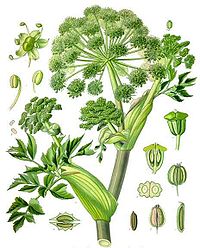
Photo from wikipedia
The seeds of Nigella sativa var. hispidula are widely used in food preparation by the Uighur people in western China. Recently, series of oleanane triterpenoid saponins were extracted from the… Click to show full abstract
The seeds of Nigella sativa var. hispidula are widely used in food preparation by the Uighur people in western China. Recently, series of oleanane triterpenoid saponins were extracted from the seeds of Nigella sativa var. hispidula, especially α-hederin as representative that exhibited strong antitumor activity. Compared to α-hederin, sapindoside B has just 1 more terminal xylopyranose in the 3-O position and displays similar effects against various human cancer cell lines with cisplatin. Considering this potential cytotoxic activity, a reliable LC-MS/MS method was developed to quantify sapindoside B in rat plasma, urine, and feces. Chromatographic separation was conducted on an Agilent Zorbax SB-Aq (3.0 × 150 mm, 3.5 µm) column via an isocratic elution procedure with acetonitrile and water containing 0.1% formic acid. Mass spectrometric detection was coupled with an electrospray ionization source in the MRM mode. The linear range of calibration curves was 15 ~ 3000 ng/mL in plasma/urine and 30 ~ 3000 ng/g in feces. The intra-day and inter-day precision was less than 11.1%, and accuracy ranged from 92.2% to 108.7%. The proposed method was validated and shown to be reliable, precise, and accurate and was successfully applied to its pharmacokinetics and excretion studies. Sapindoside B exhibited dosage-dependent pharmacokinetics in the range of 2.5 mg/kg to 12.5 mg/kg, and only about 2% of intravenous dose of sapindoside B was excreted by the feces and urine in its unchanged form over 48 h. These results provide further data support for evaluating the druggability of sapindoside B.
Journal Title: Planta medica
Year Published: 2020
Link to full text (if available)
Share on Social Media: Sign Up to like & get
recommendations!